By Tim Britten, carsales.com.au
Hyundai had no performance pedigree before the i30 N hot hatch stormed on the market in 2018. Sure, the South Korean brand had dabbled in sports coupes and lukewarm hatchbacks before, but nothing serious – or great.
But then it poached some of the industry’s most respected engineering talents and came out swinging with the original, manual-only i30 N, which received critical acclaim and has since built a passionate community of loyal enthusiasts.
Now, Hyundai has updated the i30 N with a mid-life facelift that brings a host of new features, including more power, bigger brakes, lighter wheels, revised suspension and, most importantly, an optional eight-speed dual-clutch automatic gearbox for the first time.
All of which have further cemented the i30 N as a must-drive hatch that is among the best of its type. So, let’s find out why…
More for more
Originally launched in 2018 with an attractive sub-$40,000 price tag, the facelifted Hyundai i30 N has become more expensive due to its long list of upgrades and inflationary pressures take a grip on the market.
Even still, the entry level the Korean hot hatch remains a quite bearable proposition at $46,200 plus on-road costs.
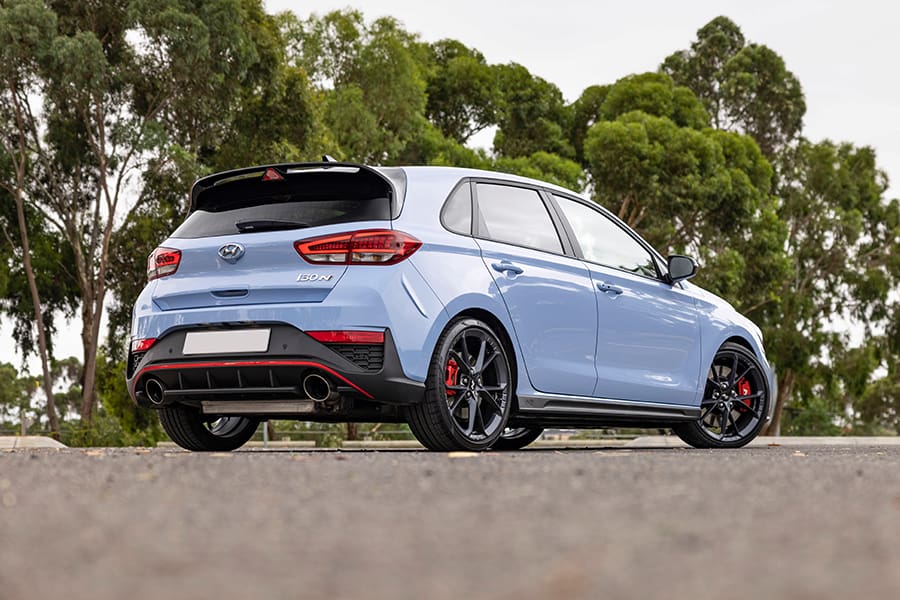
Now with manual or dual-clutch transmissions, and standard or Premium variants to choose from, there are four Hyundai i30 N hatchbacks available as permanent members of the model range – along with the i30 Sedan N, KONA N SUV and smaller i20 N pocket rocket.
Our focus is on the hatch with this review, tested here in flagship 2022 Hyundai i30 N Premium guise with the DCT auto and panoramic sunroof that starts at $53,700 plus ORCs.
That’s $3000 above the Premium model with a manual gearbox, which can also be had without a sunroof, saving you another $1500 if you choose.
In any case, the i30 N Premium DCT has a comprehensive list of standard equipment that includes push-button start, wireless phone charging, special lightweight front seats with Alcantara trim, a heated steering wheel, rear privacy glass and 10.25-inch touchscreen with sat nav and Apple CarPlay and Android Auto connectivity.
The i30 N is covered by Hyundai’s virtually industry-standard five-year/unlimited-kilometre warranty with pre-advised service pricing, 12 months of roadside assist from new and a sat-nav update subscription plan.
Un-rated
The 2022 Hyundai i30 N includes many of the familiar preventative items under what the company calls the ‘SmartSense’ safety suite.
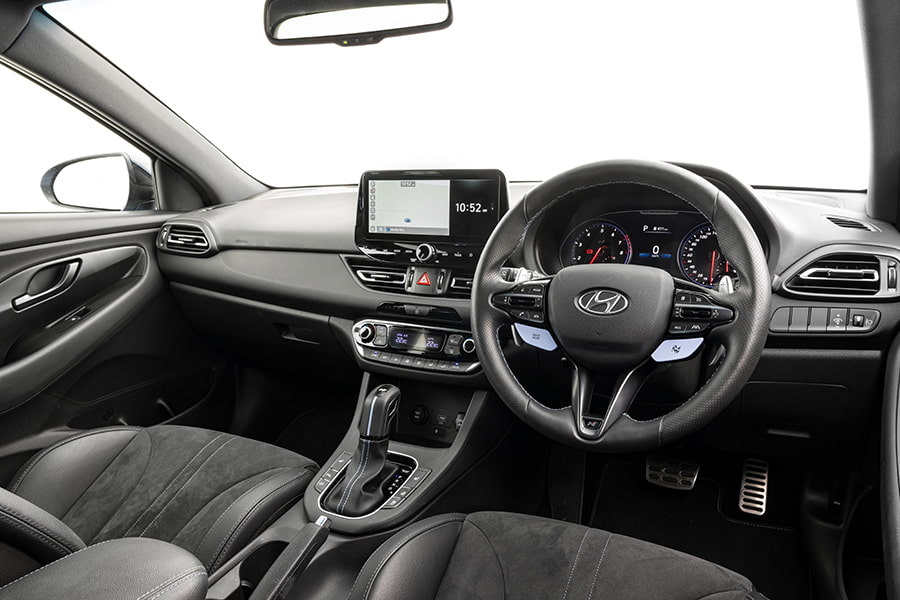
This includes radar/camera autonomous emergency braking (AEB) – operating at low-speed only and including reverse – pedestrian avoidance (but not cyclists or intersection assist), semi-autonomous lane following, lane departure warning, lane keep assist, blind spot monitoring with active assist, rear cross traffic alert with braking, front and rear parking sensors, driver attention detection and a reversing camera.
While other Hyundai i30 models get a five-star ANCAP safety rating, the i30 N continues without as it has not been tested separately from the range.
Now you’re torquing
Boasting a long list of performance-enhancing technology such as an electronic limited-slip differential, launch control, adaptive variable-rate suspension and, in the boot, a body torsion-enhancing brace connecting right and left suspension struts, the 2022 Hyundai i30 N is clearly more than the run-of-the-mill i30s.
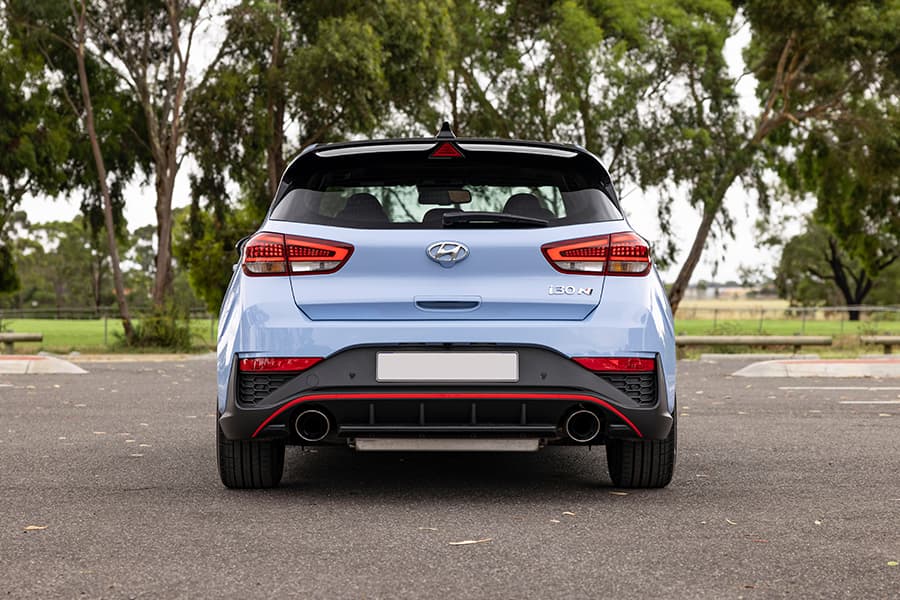
With 206kW of power, the latest i30 N produces a smidge more power at the same 6000rpm as before, while cranking out a worthwhile 35Nm torque increase – from 353Nm to 392Nm – over a shorter, higher-revving band starting at 2100rpm.
As there’s been no real weight shift apart from the DCT version which adds 33kg, the i30 N’s basic power-weight ratios remain about the same.
But the DCT-equipped i30 N is significantly quicker than before, owing to the lightning-fast shifting and the eight ratios of its dual-clutch transmission.
The wet-clutch DCT, which can be either smooth or brutal depending on the chosen drive setting, is crisply efficient in any mode and generally free of any dual-clutch misdemeanours.
Even though the engine’s torque operates over a slightly higher rpm range, the acceleration is explosive, with no discernible torque tag.
Sprinting from 0-100km/h in a claimed 5.4 seconds, the DCT chews a substantial 0.7sec off the six-speed manual i30 N’s 6.1sec (a figure that happens to be identical to the original manual i30 N).

Of course, more muscle means more increased thirst and Hyundai’s figures tell us the latest i30 N’s consumption of 98RON fuel, for both manual and DCT versions, is 8.5L/100km on the combined cycle. Hyundai claimed 8.0L/100km for the original manual-only version.
The power increases come with an emissions penalty too; previously, the manual-only i30 N was quoted at 186g/km, but now it’s 197g/km for the DCT and 199g/km for the manual.
The bright side to all this is that real-world consumption figures – in our case at least – match the official claims.
Our DCT-equipped i30 N Premium, at a recorded 8.5L/100km over a week of spirited driving, aligned perfectly.
A la mode
Typical of the latest generation of high-performance cars, the 2022 Hyundai i30 N offers so many modes and sub-modes that the driver is spoiled for choice.
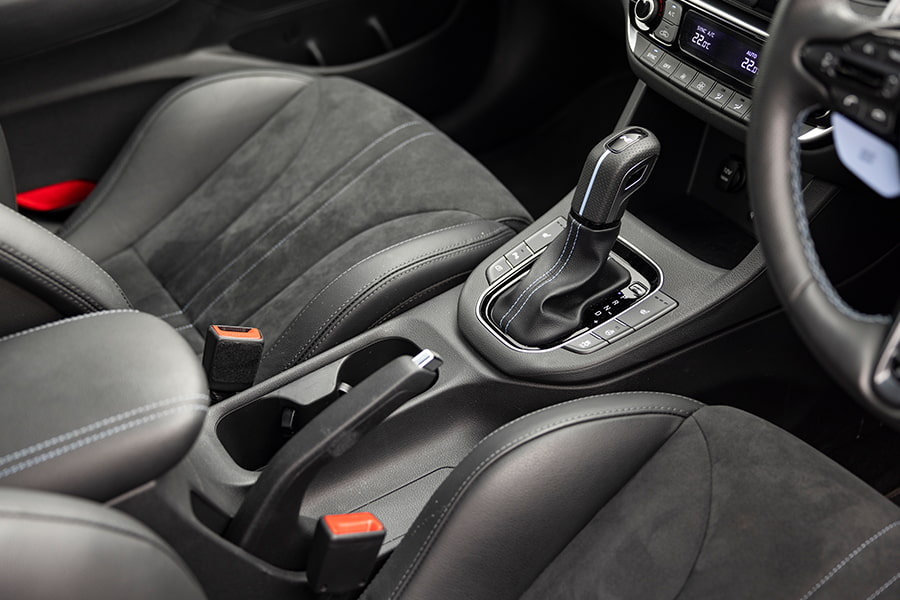
The suite of available dynamic behaviours includes Eco, Normal, Sport, N and N Custom – the latter further breaking down into selectable Eco, Normal, Sport and Sport+ functions.
Each mode brings a very different experience, though the biggest differences are to be found between the Sport and Sport+ settings.
In Sport mode, the i30 N’s suspension tightens up noticeably, the upshifts come sooner and the thoroughly tweaked and sound-enhanced exhaust system becomes more vocal, producing the obligatory exhaust bark on upshifts.
Select Sport+ and the whole thing gets more frantic again. With the newly rerated adaptive suspension fully screwed down and the shifts becoming more urgent and frequent, it’s a no-compromise setting you’d really only want to use on the racetrack.
There’s quite a bit going on in terms of different driving behaviours in the i30 N, much of it coming from three new functions brought with the 2021 update.
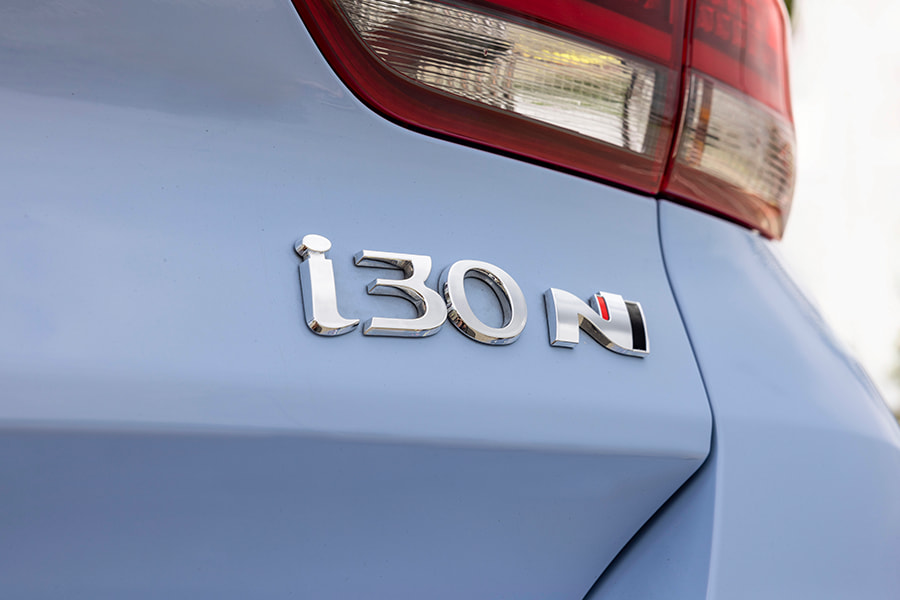
In what seems an obvious tilt to Tesla’s Ludicrous mode function, Hyundai has added what it calls N Grin Shift to the i30 N’s vocabulary – a system that, when the driver presses a button on the steering wheel, immediately boosts power and sharpens the transmission responses to maximum effect for just 20 seconds.
Also new, an N Power Shift function squeezes extra rpm from the engine when the throttle is slammed to the floor, while the N Track Sense Shift protocol figures out when it’s time for the gearbox to engage with maximum, competitive enthusiasm on the racetrack.
Everyday rewards
Even when driven in its most conservative mode, the 2022 Hyundai i30 N is flagrantly audible.
At its most wildly aggressive, it asks for some respect as the front-drive layout struggles to minimise the inevitable torque-steer which sets in with some venom when accelerating hard on rough surfaces.
Although the i30 N is notable for its well-resolved balance of engine performance, handling and road grip, it goes without saying that there’s need for concentration when flooring the accelerator, even in a straight line.
In more regular use, the small Hyundai high-performance hatch behaves in a relatively benign way.
It copes with variable road surfaces quite capably, the variable suspension offering enough compliance in its softest setting to sort out all but the most abrupt bumps as the 235/35R19 Pirelli P Zero tyres provide serious road grip.
The brakes, now upsized in the front, are formidable, while the retuned steering is quick and precise, with just 2.1 turns from lock to lock.
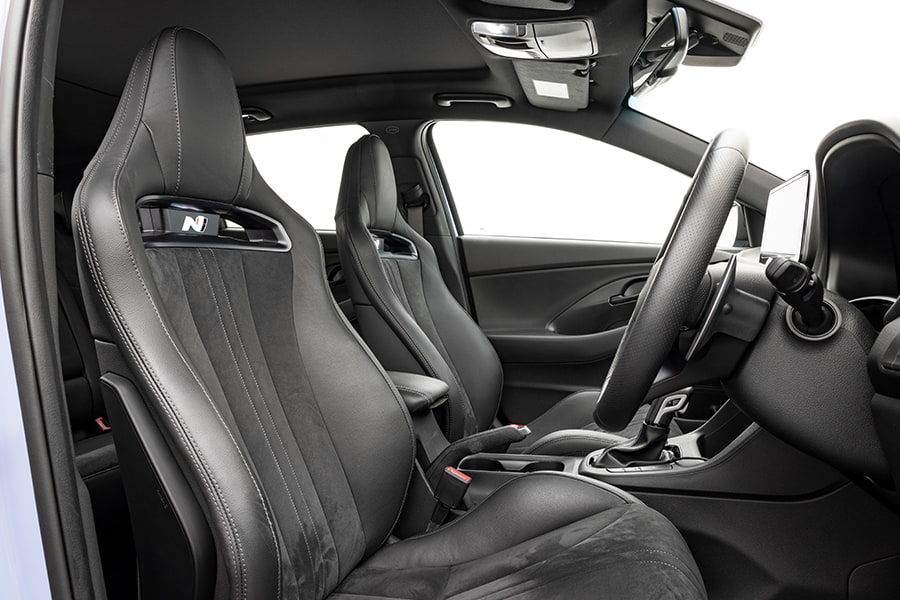
The N Light seats – standard at N Premium level – hug the driver and front passenger confidently and competently. Weighing 2.2kg less than the standard seats, they work with the 14.4kg saved by the lighter, forged alloy 19-inch wheels to help reduce unsprung weight.
In terms of being a comfortable cruiser there’s not much to complain about.
The lack of air vents for the rear passengers is common enough among small cars, the N Light front seats only adjust manually but compensate in other ways and the missing-in-action adaptive cruise control is a surprise at best and a puzzling inconvenience – in a car costing $53,700 plus ORCs – at worst.
At the end of the day, the Hyundai i30 N Premium is an impressive performance package that, however you choose to look at it, asks for few compromises.
Going fast
As hot hatches go, they really don’t come any more convincing than the 2022 Hyundai i30 N.
It’s hard to think of a moment when the i30 N Premium doesn’t reward the driver or, for that matter, the passengers.
Its multifaceted appeal lies in the broad spread of capabilities and a serious lack of compromise regardless of the scenario it’s placed in.
It’s pretty much up for anything, from a quick visit to the shops to a day mixing it on the racetrack with other hot hatches.
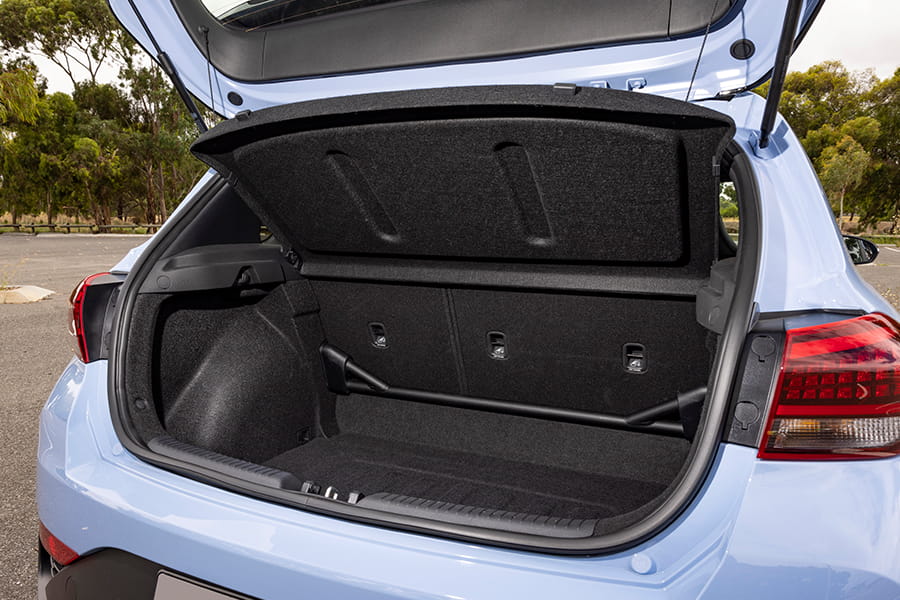
Almost as an adjunct to its demonstrated dynamic abilities, there’s also the familiar, well-proportioned and comfortable i30 cabin, a competitively sized hatchback boot, dual-zone air-con and a six-speaker sound system.
It’s not often that you get such a level of driving fun mixed with practicality in a car where the price starts in the mid-$40,000s and maxes out at not much more than $55,000 drive-away.
2022 Hyundai i30 N Premium DCT at a glance:
| Price: $53,700 (plus on-road costs) |
Transmission: Eight-speed dual-clutch automatic |
| Available: Now |
Fuel: 8.5L/100km (ADR Combined) |
| Engine: 2.0-litre four-cylinder turbo-petrol |
CO2: 197g/km (ADR Combined) |
| Output: 206kW/392Nm |
Safety rating: Not tested |
Disclaimer: Images supplied by Hyundai Australia.
This article was prepared by an independent author. The information contained in this article represents the views and opinions of the original author, and is based on research carried out by the original author. The appearance of the article on Maxxia's website does not constitute an endorsement of its content by Maxxia in any way. The article has been made available for informational purposes only and should not be taken as advice. While all reasonable care has been taken to ensure that the statements made by the original author in the article are fair and accurate, Maxxia does not guarantee or warrant the accuracy or completeness of this information and will not be liable for, or in connection with, any loss or damage suffered as a result of any inaccuracies, errors or omissions or your reliance on this information. You should independently research and verify information before making any decision in respect of a vehicle.

